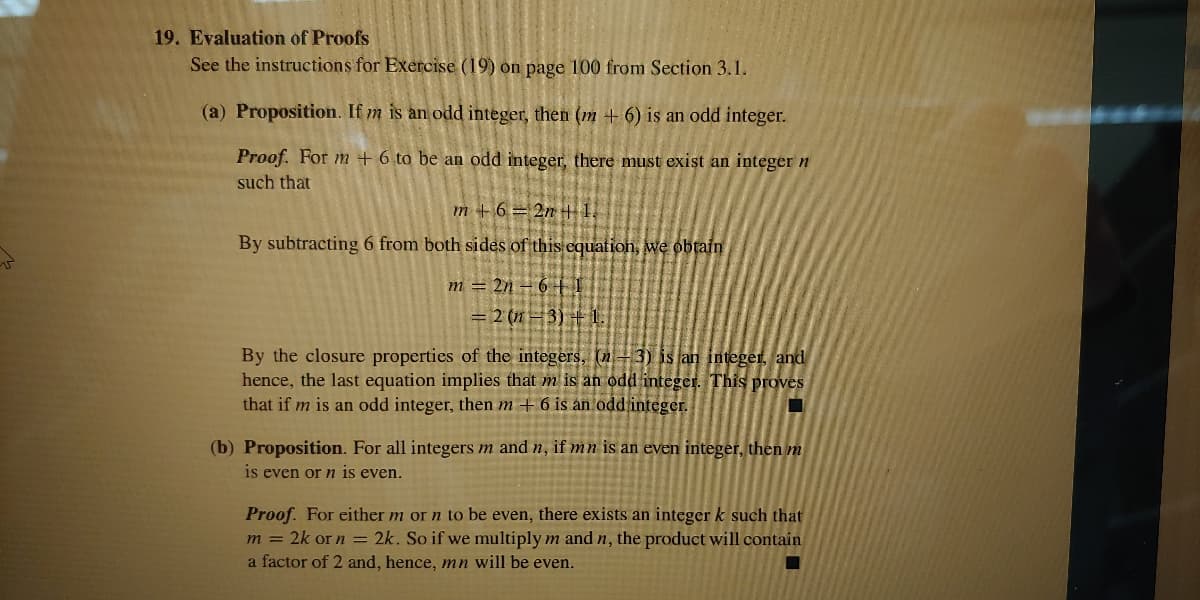19. Evaluation of Proofs See the instructions for Exercise (19) on page 100 from Section 3.1. (a) Proposition. If m is an odd integer, then (m + 6) is an odd integer. Proof. For m + 6 to be an odd integer, there must exist an integer n such that m +6=2n + 1, By subtracting 6 from both sides of this equation, we obtain m = 2n – 6 † I = 2 (n=3) +1. By the closure properties of the integers, (n÷3) is an integer, and hence, the last equation implies that m is an odd integer. This proves that if m is an odd integer, then m + 6 is an oddinteger. (b) Proposition. For all integers m and n, if mn is an even integer, then m is even orn is even. Proof. For either m or n to be even, there exists an integer k such that m = 2k or n = 2k. So if we multiply m and n, the product will contain a factor of 2 and, hence, nn will be even.
19. Evaluation of Proofs See the instructions for Exercise (19) on page 100 from Section 3.1. (a) Proposition. If m is an odd integer, then (m + 6) is an odd integer. Proof. For m + 6 to be an odd integer, there must exist an integer n such that m +6=2n + 1, By subtracting 6 from both sides of this equation, we obtain m = 2n – 6 † I = 2 (n=3) +1. By the closure properties of the integers, (n÷3) is an integer, and hence, the last equation implies that m is an odd integer. This proves that if m is an odd integer, then m + 6 is an oddinteger. (b) Proposition. For all integers m and n, if mn is an even integer, then m is even orn is even. Proof. For either m or n to be even, there exists an integer k such that m = 2k or n = 2k. So if we multiply m and n, the product will contain a factor of 2 and, hence, nn will be even.
Algebra & Trigonometry with Analytic Geometry
13th Edition
ISBN:9781133382119
Author:Swokowski
Publisher:Swokowski
Chapter10: Sequences, Series, And Probability
Section10.1: Infinite Sequences And Summation Notation
Problem 65E
Related questions
Question
19 please

Transcribed Image Text:19. Evaluation of Proofs
See the instructions for Exercise (19) on page 100 from Section 3.1.
(a) Proposition. If m is an odd integer, then (m + 6) is an odd integer.
Proof. For m + 6 to be an odd integer, there must exist an integer n
such that
m + 6 = 2n H 1,
By subtracting 6 from both sides of this equation, we obtain
m = 2n – 6 † I
= 2 (n=3) +1.
By the closure properties of the integers, (n+3) is an integer, and
hence, the last equation implies that m is an odd integer. This proves
that if m is an odd integer, then m + 6 is an odd integer.
(b) Proposition. For all integers m and n, if mn is an even integer, then m
1s even or n is even.
Proof. For either m or n to be even, there exists an integer k such that
m = 2k or n = 2k. So if we multiply m and n, the product will contain
a factor of 2 and, hence, nn will be even.
Expert Solution
This question has been solved!
Explore an expertly crafted, step-by-step solution for a thorough understanding of key concepts.
This is a popular solution!
Trending now
This is a popular solution!
Step by step
Solved in 2 steps with 2 images

Knowledge Booster
Learn more about
Need a deep-dive on the concept behind this application? Look no further. Learn more about this topic, advanced-math and related others by exploring similar questions and additional content below.Recommended textbooks for you

Algebra & Trigonometry with Analytic Geometry
Algebra
ISBN:
9781133382119
Author:
Swokowski
Publisher:
Cengage

Algebra & Trigonometry with Analytic Geometry
Algebra
ISBN:
9781133382119
Author:
Swokowski
Publisher:
Cengage